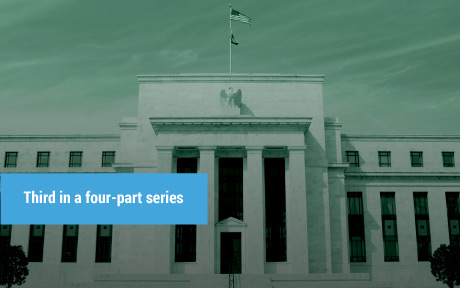Hey, Economist! What Do Cryptocurrencies Have to Do with Trust?

Bitcoin and other “cryptocurrencies” have been much in the news lately, in part because of their wild gyrations in value. Michael Lee and Antoine Martin, economists in the New York Fed’s Money and Payment Studies function, have been following cryptocurrencies and agreed to answer some questions about digital money.
Why Pay Interest on Excess Reserve Balances?

In a previous post, we described some reasons why it is beneficial to pay interest on required reserve balances. Here we turn to arguments in favor of paying interest on excess reserve balances. Former Federal Reserve Chairman Ben Bernanke and former Vice Chairman Donald Kohn recently discussed many potential benefits of paying interest on excess reserve balances and some common misunderstandings, including that paying interest on reserves restricts bank lending and provides a subsidy to banks. In this post, we focus primarily on benefits related to the efficiency of the payment system and the reduction in the need for the provision of credit by the Fed when operating in a framework of abundant reserves.
Counterparty and Collateral Policies of Central Bank Lending Facilities

In a previous post, we compared the Federal Reserve’s discount window with the standing lending facilities (SLFs) at the Bank of England (BoE), the European Central Bank (ECB), and the Bank of Japan (BoJ). We showed that the Fed’s discount window was less integrated with monetary policy than the SLFs of the other central banks. In this post, we observe that the counterparty and collateral policies of the Fed’s discount window are similarly less integrated with the practices involved in monetary policy operations, in comparison with the other central banks.
A Closer Look at the Fed’s Balance Sheet Accounting

An earlier post on how the Fed changes the size of its balance sheet prompted several questions from readers about the Federal Reserve’s accounting of asset purchases and the payment of principal by the Treasury on Treasury securities owned by the Fed. In this post, we provide a more detailed explanation of the accounting rules that govern these transactions.
How the Fed Changes the Size of Its Balance Sheet: The Case of Mortgage‑Backed Securities

In our previous post, we considered balance sheet mechanics related to the Federal Reserve’s purchase and redemption of Treasury securities. These mechanics are fairly straightforward and help to illustrate the basic relationships among actors in the financial system. Here, we turn to transactions involving agency mortgage-backed securities (MBS), which are somewhat more complicated. We focus particularly on what happens when households pay down their mortgages, either through regular monthly amortizations or a large payment covering some or all of the outstanding balance, as might occur with a refinancing.
How the Fed Changes the Size of Its Balance Sheet

The size of the Federal Reserve’s balance sheet increased greatly between 2009 and 2014 owing to large-scale asset purchases. The balance sheet has stayed at a high level since then through the ongoing reinvestment of principal repayments on securities that the Fed holds. When the Federal Open Market Committee (FOMC) decides to reduce the size of the Fed’s balance sheet, it is expected to do so by gradually reducing the pace of reinvestments, as outlined in the June 2017 addendum to the FOMC’s Policy Normalization Principles and Plans. How do asset purchases increase the size of the Fed’s balance sheet? And how would reducing reinvestments reduce the size of the balance sheet? In this post, we answer these questions by describing the mechanics of the Fed’s balance sheet. In our next post, we will describe the balance sheet mechanics with respect to agency mortgage-backed securities (MBS).
The Role of Central Bank Lending Facilities in Monetary Policy

Central bank lending facilities were vital during the financial crisis of 2007-08 when many banks and nonbank financial institutions turned to them to meet funding needs as private funding dried up. Since then, there has been renewed interest in the design of central bank lending facilities in the post-crisis period.
















 RSS Feed
RSS Feed Follow Liberty Street Economics
Follow Liberty Street Economics